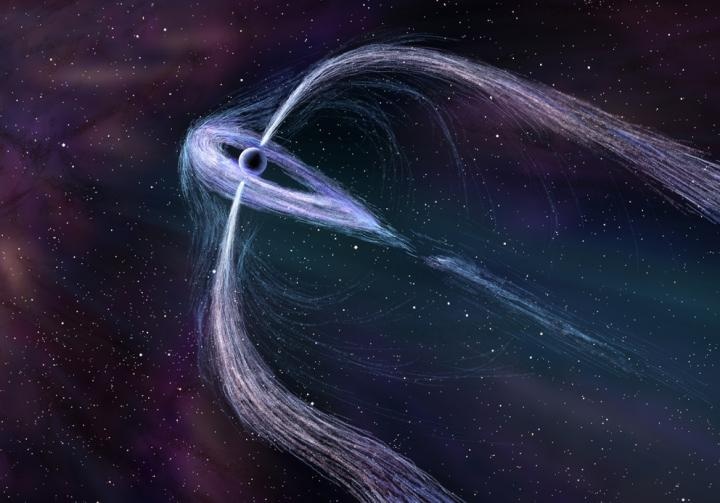Jan 18 2017
Like cosmic lighthouses sweeping the universe with bursts of energy, pulsars have fascinated and baffled astronomers since they were first discovered 50 years ago. In two studies, international teams of astronomers suggest that recent images from NASA's Chandra X-ray Observatory of two pulsars — Geminga and B0355+54 — may help shine a light on the distinctive emission signatures of pulsars, as well as their often perplexing geometry.
 An artist's representation of what the three unusual tails of the pulsar Geminga may look like close up. NASA's Chandra X-ray Observatory is giving astronomers a better look at pulsars and their associated pulsar wind nebulae, enabling new constraints on the geometry of pulsars and why they look the way they do from Earth. (Credit: Nahks Tr'Ehnl)
An artist's representation of what the three unusual tails of the pulsar Geminga may look like close up. NASA's Chandra X-ray Observatory is giving astronomers a better look at pulsars and their associated pulsar wind nebulae, enabling new constraints on the geometry of pulsars and why they look the way they do from Earth. (Credit: Nahks Tr'Ehnl)
Pulsars are a type of neutron star that are born in supernova explosions when massive stars collapse. Discovered initially by lighthouse-like beams of radio emission, more recent research has found that energetic pulsars also produce beams of high energy gamma rays.
Interestingly, the beams rarely match up, said Bettina Posselt, senior research associate in astronomy and astrophysics, Penn State. The shapes of observed radio and gamma-ray pulses are often quite different and some of the objects show only one type of pulse or the other. These differences have generated debate about the pulsar model.
"It's not fully understood why there are variations between different pulsars," said Posselt. "One of the main ideas here is that pulse differences have a lot to do with geometry — and it also depends on how the pulsar's spin and magnetic axes are oriented with respect to line of sight whether you see certain pulsars or not, as well as how you see them."
Chandra's images are giving the astronomers a closer than ever look at the distinctive geometry of the charged particle winds radiating in X-ray and other wavelengths from the objects, according to Posselt. Pulsars rhythmically rotate as they rocket through space at speeds reaching hundreds of kilometers a second. Pulsar wind nebulae (PWN) are produced when the energetic particles streaming from pulsars shoot along the stars' magnetic fields, form tori — donut-shaped rings — around the pulsar's equatorial plane, and jet along the spin axis, often sweeping back into long tails as the pulsars' quickly cut through the interstellar medium.
"This is one of the nicest results of our larger study of pulsar wind nebulae," said Roger W. Romani, professor of physics at Stanford University and principal investigator of the Chandra PWN project. "By making the 3-D structure of these winds visible, we have shown how one can trace back to the plasma injected by the pulsar at the center. Chandra's fantastic X-ray acuity was essential for this study, so we are happy that it was possible to get the deep exposures that made these faint structures visible."
A spectacular PWN is seen around the Geminga pulsar. Geminga — one of the closest pulsars at only 800 light years away from Earth — has three unusual tails, said Posselt. The streams of particles spewing out of the alleged poles of Geminga — or lateral tails — stretch out for more than half a light year, longer than 1,000 times the distance between the Sun and Pluto. Another shorter tail also emanates from the pulsar.